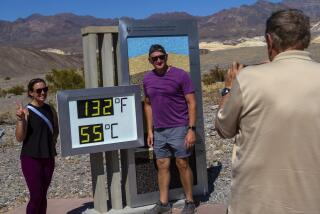India Heat Wave Breaks 50-Year Record in Capital
NEW DELHI — Even for India, notorious for heat and dust, this season has been a sizzler.
How hot has it been? On Monday, New Delhi sweated through its hottest afternoon in half a century, with the mercury shooting up to 114.8 degrees.
In the arid, mostly desert state of Rajasthan to the southwest of the Indian capital, at least 71 people have died over the past few days of heat stroke, news reports said. In the towns of Phalodi and Jhalawar, it was an overpowering 118.4 degrees. Dust storms were forecast for some areas.
Rajasthan’s chief minister, Bhairon Singh Shekhawat, said more than 22,000 villages are in the grip of a severe drought caused by the two-week heat wave. The state will spend almost $65 million on aid and make-work programs for farmers whose crops have been singed in the fields, he said.
New Delhi’s wide streets were deserted during much of the day as wary residents avoided the burning sun and breezes that felt like exhaust venting from a brick kiln. Electric current ebbed and surged throughout the day, sometimes failing entirely, as the already overtaxed power grid strained to run all the air conditioners and fans switched on in this city of more than 8 million people.
Like the British before them, many of India’s high and mighty fled the burning plains of northern India for the cooler hills. On a single day recently, 10 government VIPs were sighted in Dehra Dun, ostensibly on some official business.
Finance Minister Manmohan Singh went to unveil a statue of Buddha at a hospital. Rajesh Pilot, minister of state for external security, was chief guest at a function staged by the Indo-Tibetan border police. Pressed by a reporter, he admitted he intended to relax in the coolness of the nearby hill station of Mussoorie for four days.
For those left behind at lower altitudes, no relief is in sight, forecasters warned. Ram Snehi, director of the Safdarjung Meteorological Office in the capital, said Monday that over the next few days, “the maximum temperature may, at the most, show a difference of about a half a degree only, but no dramatic change is expected.”
Even rain, which could occur in the next 24 hours, wouldn’t bring the temperature down much, Snehi said. And it could even get hotter. “Further rise in the temperature is not ruled out, though it should not happen. But the weather is unpredictable,” Snehi said.
May is generally the hottest month of the year for Delhi. The weatherman’s outlook was bad news for people across North India, who now must look forward to another month of intense heat before the arrival of the cooling rains of the monsoon, expected to reach Delhi June 29. May 29, 1944, remains the hottest day on record in India’s capital, with the temperature peaking at 117 degrees.
More to Read
Sign up for Essential California
The most important California stories and recommendations in your inbox every morning.
You may occasionally receive promotional content from the Los Angeles Times.










